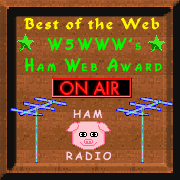

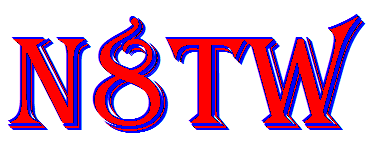


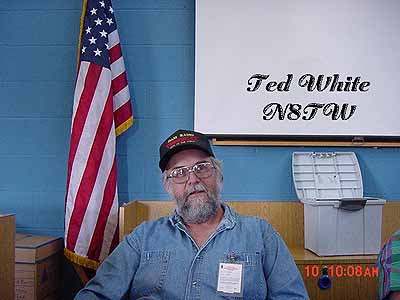



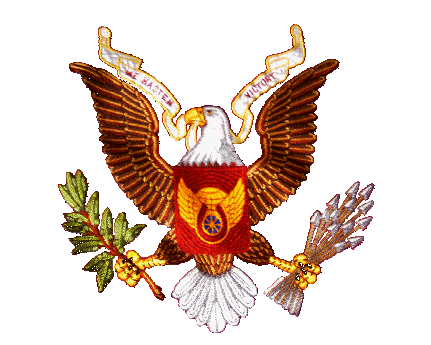


We live in a mobile home, in a park where antennas are not allowed, and I have tried several antennas, from mobile HF antennas, using a magnetic mount on a metal box inside the home, to using the aluminum trim around the top of the home, that seperates the vinyl siding from the asphalt shingle roof. This worked good, but being in 10 foot long sections, the joints were giving me some problems, especially when the weather changed. So I decided to try using a single wire, wrapped and hidden around the home. Having vinyl siding really helps.

The pictures, and description, are of the present station set-up here. The station consists of a Yaesu FT-857D transceiver, MFJ-986 antenna tuner, RIGblaster Nomic, and I use MixW software on the digital modes. I usually work the digital modes(PSK, MFSK, MT63, Hellschreiber, and RTTY), and also CW. Some SSB, but not much. The power output is kept at about 75 watts, while usually running about 25 on PSK. The picture on the right, is the newest of the 2 pictures, as it shows a 15 inch flat-screen monitor given to me by our youngest son before he left for active duty with the Army. I also changed a few other items between the times the pictures were taken to make it easier to operate. One change involved getting a new "All in One" printer. This allows me to scan, print, copy, and some other things I'm still learning to do with one item, saving desk space. The old scanner was in the space next to the key, but now I can put the keyboard in that space when it is not used.
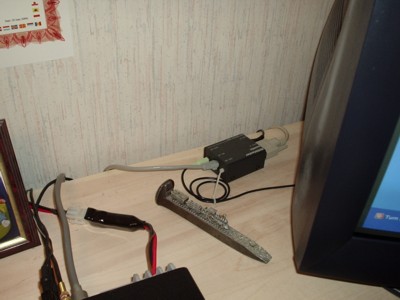

The above 2 pictures show some of the operating set-up, with the 1st picture showing an overhead view of the RigBlaster Nomic at the rear of the monitor. The grey cable coming from the Left of the Nomic goes to the microphone input on the FT-857D. This cable can be unplugged from the Nomic, at this location, and plugged into a straight connector, that has a microphone plugged into it, so the radio can be used on voice, without having to remove the front face of the radio. The 2nd picture shows the toroid core I have installed on the microphone cable, under the shelf to help stop any stray RF from getting into the audio input of the radio. The toroid core is a 4 section snap-on, available at most electronic dealers. The cable coming from the Nomic, loops several times thru the core before it plugs into the microphone input on the radio, and is suspended under the shelf with 2 nylon ties on a shelf support leg. This is an RF fix that I have used for many years, and when using an antenna that is not at a distance from the station, RF can be a problem. This can be a problem with open-wire, or long wires that run directly from a tuner, such that I have here. No stray RF has been reported on signals from here, so the toroids are a simple fix, to a potential problem.
When using CW, I just set the computer keyboard to the right of the Vibroplex "Lightning Bug" and CW is no problem. In August, 2007, I started having problems using the Vibroplex key. I switched over to using an old "J-37" straight key that was given to me, and had belonged to "W9EMT", who had passed away. The key is mounted on a piece of wood, from an old cheese box. The bottom of the wood tells briefly about the cheese. The key might look bad, but works very well. I have tried to clean it, but whoever owned it before smoked very heavy, I was told. The callsign "W9EMT" is scratched in the finger-piece. Having a key like this makes me wonder about the previous owner.
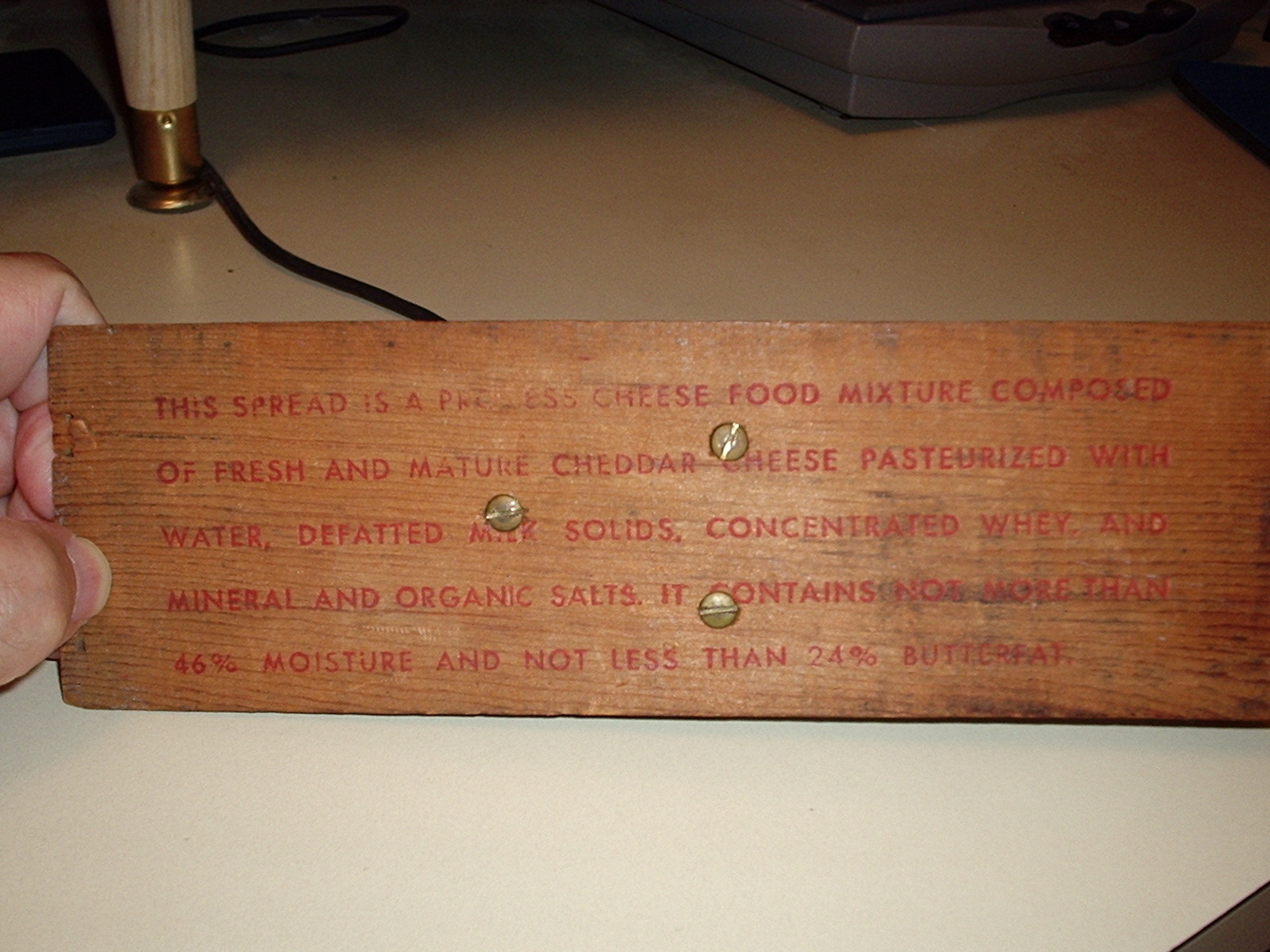

I also use a Kenwood TM-G707A transceiver on 145/440 Mhz FM, with the antenna being located in the wooden shed at the rear of the home. The antenna is a short dual band antenna, using a magnetic base on a steel plate, in the rafters of the storage shed at the rear of the home. FM repeaters can be worked up to a distance of 25 miles.
The HF antenna consists of a white coated, number 12 wire, 120 feet in length, from an antenna terminal on the tuner, and encircling the outside of the home. As there is no longwire terminal on the tuner, the wire is soldered into a PL-259 connector and plugged into an antenna terminal on the tuner, as seen in picture number 2. I installed a rubber faucet washer in the connector, to keep the wire centered where it exits the connector. Then a small piece of electrical tape to keep the washer from sliding out.

The wire starts at an antenna terminal on the rear of the tuner, goes down through a hole in the floor, through the crawl space under the home, to the nearest outside corner. The mobile home is constructed like a normal home, with vinyl siding, but with vinyl skirting, where a concrete or block foundation would be on a normal home. The nearest or first corner, is the corner with "10567" on it, which is our street address.
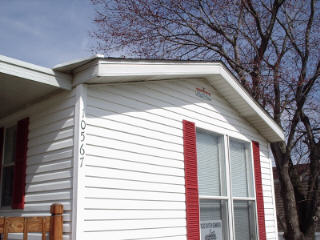
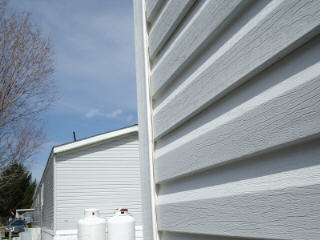
The wire then runs vertical up the inside of the corner, across the end of the home, under the overhang of the roof, then down the next corner. In looking at the above picture of the corner, in picture #4, if you look close you can see the wire tucked into the corner. The white coating of the wire blends in with the white vinyl, and hides it very well. This is the same on all 4 corners. From there it continues the length of the home, hidden from view or touch, suspended in the floating head of the skirting. When it reaches the end of the home, it continues vertically up the 3rd corner, across the end of the home, like the other end, down the 4th corner, and continues along the home towards the front, again hidden and suspended by the floating head of the skirting. The wire runs under a wooden deck, and terminates there with a wire nut. The antenna is about 2 feet above ground, on average, with the highest points being about 12 feet above ground, at the peaks on the ends of the home.

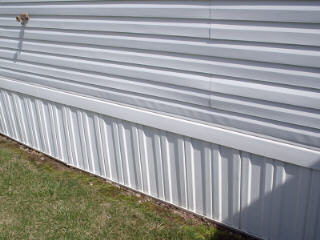
A ground wire runs from the back of the tuner to a steel tie-down post under the home to provide a ground for the station.
The pictures show several ways I have used to support and hide the wire. At the corners, the wire is tucked into the corner and held there by the end of the horizontal siding. In the floating head of the skirting, the wire is supported by hooks, used to hang pictures, with one end of the hook pressed lightly around the wire, and the other end hanging on the top of the skirting. This is done every 5 or 6 feet, and keeps the wire hidden, both from people and the weather. At the ends of the home, the wire is hidden between the top piece of the vinyl siding(a "J" channel) and the facia part of the overhang.
I have pulled the wire out at some points to show it, but when tucked in, it is out of sight. In picture #5, I show how the wire is supported on the skirting, with the picture hooks, but when the top of the skirting is in the floating head, this is not seen. Normally it looks like picture #6.
My wife and I have lived here over 15 years, and no-one knows about the station. With the different regulations and ordinances restricting Amateur antenna installations, some ingenuity has to be tried, and this one works for me. I work all bands 160-10, and even though I don't have the loudest signal, I still enjoy Ham Radio, after 42 years.
In 1995 I was diagnosed with Multiple Sclerosis, but it didn't get worse till March, 2002. In May, 2002, my Neurologist took me off work, as a Plumber, and certified that I would never work again. My wife is diabetic, so we try to stay active, even with her working 50-60 hours a week. Amateur Radio has helped me stay active.





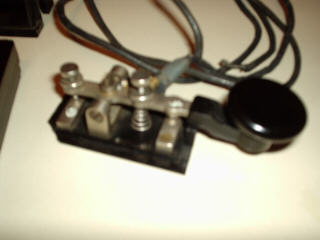
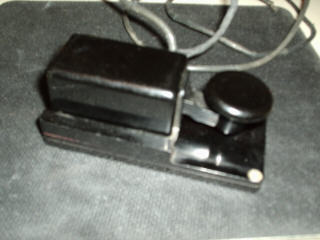


I have to include this, even if just for old times sake. In 1966, I was in High School, and using a Hallicrafters SX-24 receiver to listen to Shortwave stations such as "Radio Moscow", "BBC", "VOA", "Radio Prague", and quite a few others. It was fun to listen to all the stations, and try to see who was telling more truth than the others. I got the monthly magazine "Popular Electronics" at the local bookstore, and 1 day noticed an article about getting a free, SWL identifier. So I filled out the application, sent it in, and received the SWL identifier "WPE8JHB". I still keep that certificate as a reminder of how I started listening to SW, and then got interested in Ham Radio. Along with those stations I mentioned, I remember lot's of "Hams" on 3.5, 7 and 14 MC AM that I listened to. Those were "GOOD TIMES".
The following plaque was presented to me 8-5-1981 at a club meeting, of the Butler County VHF Association (W8CCI), in Hamilton, Ohio. In 1980 through 1982 I was President of that club and grew up just outside that city. I helped a lot of people with CW, and the plaque was 8 peoples way of saying "Thanks" but they were the people staying with becoming better at CW. Looking at the calls, some are "Silent Keys", some are still active , but all were, and will always be considered friends.



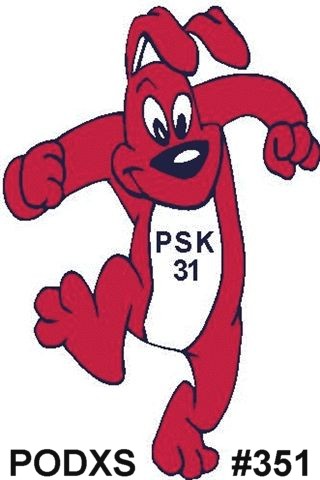





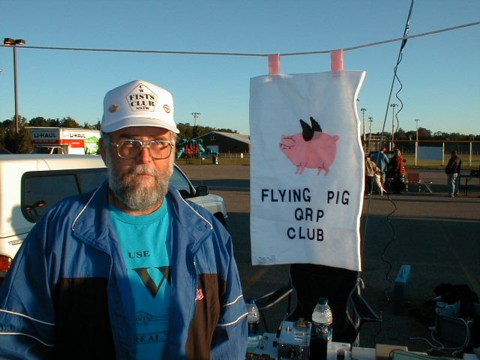
 |
This RingSurf Amateur Radio Net Ring Site is owned by Ted, N8TW. |  |